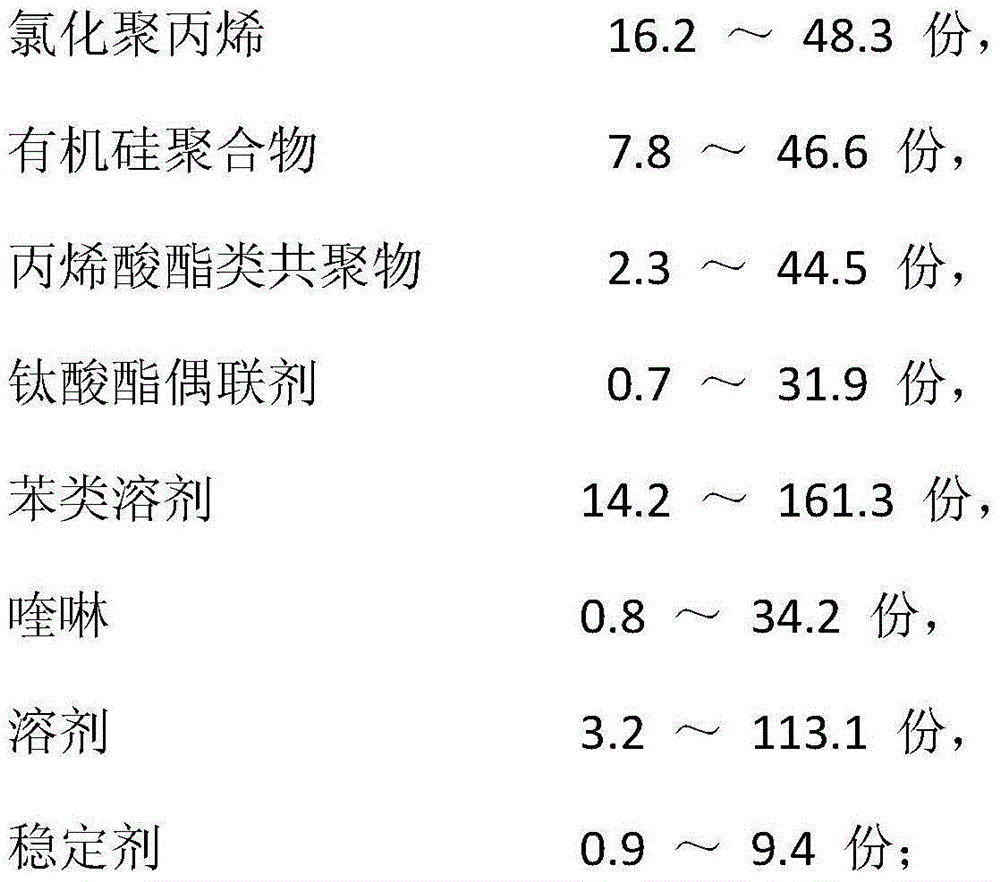A primer for difficult-to-adhesive materials and preparation method thereof
A primer and difficult-to-adhesive technology, applied in the direction of coating, etc., can solve the problems of low bonding strength, safety, and large investment in equipment, and achieve excellent performance, simple preparation method, and no need for polymerization.
- Summary
- Abstract
- Description
- Claims
- Application Information
AI Technical Summary
Problems solved by technology
Method used
Image
Examples
Embodiment 1
[0031] 16.2 parts of chlorinated polypropylene (molecular weight 17000), 8 parts of chlorobutyltrimethoxysilane, 2.3 parts of acrylic acid / butyl acrylate random copolymer (molecular weight 23000), 0.7 parts of tetrabutyl titanate, 161.3 parts of toluene, 0.8 parts of quinoline, 3.2 parts of isopropanol, and 0.9 parts of light stabilizer 1010 were mixed and stirred for 1 hour, and the solid content was adjusted to 6.6-13.3% at 77-110°C by evaporating and refluxing. The performance test of the prepared primer is shown in Table 1.
Embodiment 2
[0033] 32 parts of chlorinated polypropylene (molecular weight 17000), 43 parts of chlorobutyl trimethoxysilane, 23.4 parts of acrylic acid / ethyl acrylate / hydroxypropyl acrylate copolymer (molecular weight 32000), 5 parts of tetrabutyl titanate, two 87.7 parts of toluene, 15 parts of quinoline, 91 parts of ethanol, and 4 parts of light stabilizer 944 were mixed and stirred for 1 hour, and the solid content was adjusted to 6.9-7.5% by evaporation and reflux at 77-110°C. The performance test of the obtained primer is shown in Table 1.
Embodiment 3
[0035] 48.3 parts of chlorinated polypropylene (molecular weight 84000), 27.2 parts of aminobutyldimethoxy-terminated polydimethylsiloxane, 34 parts of acrylic acid / methyl acrylate / hydroxypropyl acrylate copolymer (molecular weight 29000), 15 parts of tetrabutyl titanate, 58 parts of xylene, 4 parts of quinoline, 58.1 parts of dichloroethane, 5 parts of light stabilizer 944, mixed and stirred, stirred for 1 hour, adjusted by evaporation and reflux at 77-110 ° C The solid content is 8.5-18.3%. The performance test of the obtained primer is shown in Table 1.
PUM
 Login to View More
Login to View More Abstract
Description
Claims
Application Information
 Login to View More
Login to View More - R&D
- Intellectual Property
- Life Sciences
- Materials
- Tech Scout
- Unparalleled Data Quality
- Higher Quality Content
- 60% Fewer Hallucinations
Browse by: Latest US Patents, China's latest patents, Technical Efficacy Thesaurus, Application Domain, Technology Topic, Popular Technical Reports.
© 2025 PatSnap. All rights reserved.Legal|Privacy policy|Modern Slavery Act Transparency Statement|Sitemap|About US| Contact US: help@patsnap.com

